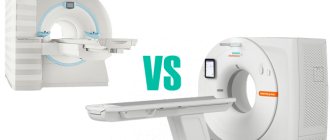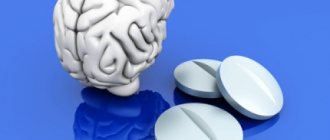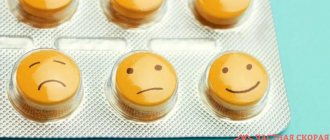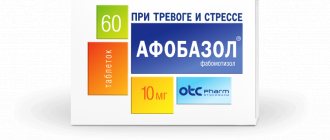Anonymously
Around the clock
Attention! The material contains information about substances, the use of which can cause serious harm to your health!
Neuroleptics are antipsychotic drugs that are used to treat severe mental conditions such as mania, hallucinosis, or psychosis. Despite their widespread use in medical practice, tranquilizers are also used to achieve a drug “high”: this leads to the development of severe pharmaceutical dependence.
- What are neuroleptics?
- The effect of neuroleptics on the body
- Signs of antipsychotic drug use
- Side effects from antipsychotics
- Contraindications
- Types of antipsychotics
- Typical antipsychotics
- Atypical antipsychotics
- New generation neuroleptics
- The safest antipsychotic
- Neuroleptics without sedation
- List of antipsychotics
- First generation neuroleptics
- Second generation neuroleptics
- Neuroleptics of the latest generation
- Consequences of neuroleptics
- Neuroleptics and alcohol
- Antipsychotic drug poisoning
- Dyskinesia from neuroleptics
- Insomnia
- Disorders of the nervous system
- Overdose of antipsychotics
- FAQ
- When are antipsychotics prescribed?
- What is neuroleptic syndrome?
- Can you buy antipsychotics without a prescription?
- How to get off antipsychotics? Help from specialists at the Zdravnitsa clinic
Treatment prices:
| Service | Price, rub) |
| Types of therapies | |
| Standard detoxification therapy | 3 500 ₽ |
| Double Detox Therapy | 6 000 ₽ |
| Enhanced Detoxification Therapy | 7 500 ₽ |
| Maximum detoxification therapy | 9 500 ₽ |
| Quick sobering up at home | 7 500 ₽ |
| Hospital at home 1 day | 22 000 ₽ |
| Advanced hospitalization | 15 000 ₽ |
| Treatment in hospital | |
| Accommodation | |
| Economy chamber (6 beds) | 2 000 ₽ |
| Standard room (4 beds) | 3 000 ₽ |
| Increased comfort (2 seater) | 5 500 ₽ |
| VIP chamber (1 person) | 12 500 ₽ |
| Individual post 24/7 | 5 000 ₽ |
| Medical and social rehabilitation 21 days | 140 000 ₽ |
| Service | Price, rub) |
| Initial consultation with a narcologist | for free |
| Consultation with a psychologist | 3 000 ₽ |
| Psychiatrist consultation | 5 000 ₽ |
| Coding at home Torpedo | 7 500 ₽ |
| Express output and encoding (doublet) | 13 500 ₽ |
| Coding using the Dovzhenko method | 12 000 ₽ |
| Hypnosis classic session | 13 000 ₽ |
| Ericksonian hypnosis session (NLP) | 8 000 ₽ |
| Coding method Torpedo | 5 500 ₽ |
| Double block | 8 000 ₽ |
| Esperal injection for 1 year | 9 900 ₽ |
| Tetlong for 3 months | 10 500 ₽ |
| Esperal gel for 1 year | 15 000 ₽ |
| Selincro course of therapy | 12 500 ₽ |
| Implantation of Disulfiram for 1 year | 18 000 ₽ |
| Vivitrol injection for 1 month | 26 000 ₽ |
| Naltrexone stitching for 3 months | 35 000 ₽ |
| Neuroimplantation Prodetoxon for 6 months | 47 500 ₽ |
| Narcopsychotherapy session | 50 000 ₽ |
| Neutralization of encoding | specify |
| Psychodiagnostics / pathological diagnostics | 7 500 ₽ |
| Psychotherapy session | 5 000 ₽ |
| Family psychotherapy | 6 000 ₽ |
| Outpatient rehabilitation in Moscow | 33 000 ₽ |
Expand
We will select an individual treatment plan
Free consultation 8-800-200-27-23
Signs of antipsychotic drug use
To reduce the side effects of antipsychotic drugs, antidepressants and other stimulants are used in psychiatric practice. The selection of relevant pharmaceuticals requires a long time and careful monitoring by medical personnel.
Recreational use of tranquilizers leads to dramatic changes in a person's appearance and behavior. If the behavior and appearance of a loved one has changed, you should pay attention to the following symptoms of drug addiction:
- Reduced reaction speed, general inhibition;
- Slow speech;
- drooping eyelids;
- Drowsiness, hypersomnia;
- Sudden weight loss or gain;
- Pallor of the skin and mucous membranes;
- Decreased intellectual abilities;
- General negligence of appearance. Due to weakness, the addict neglects personal hygiene, cleaning the apartment, and so on.
Some drug addicts combine taking tranquilizers with alcohol. As a result of this combination, the liver is destroyed, which leads to serious illness and changes in appearance: brittle hair, nail plates, yellowing of the skin, and so on.
MOTIVATION OF A DEPENDENT FOR TREATMENT
Tranquilizers for depression and neurosis
Kinds:
- sleeping pills;
- sedatives;
- muscle relaxants.
In the first case, there is a significant reduction in anxiety, the quality of sleep improves and the duration of sleep increases. Doctors do not recommend taking sleeping pills for a long time or independently extending the period of use prescribed by a specialist, since drugs in this group can cause drug dependence. Because of this feature, sleeping pills are popular among pharmacy drug addicts.
Sedatives have a positive effect on the central nervous system; they can be either herbal or synthetic and have a rather mild effect on the central nervous system. They help restore balance between the excitation and inhibition systems, enable a person to react more calmly to stressful situations and eliminate sleep problems.
Muscle relaxants are medications that reduce the tone of the skeletal muscles and reduce motor activity. They block H-cholinergic receptors and stop the supply of impulses to the muscles, due to which they stop contracting.
Tranquilizers are used for depression and panic attacks, sleep problems, as well as for:
- behavioral and mental disorders;
- neuroses;
- psychosis;
- personality disorders;
- causeless fears;
- schizophrenia;
- when relieving abstinence from alcohol and drug addiction;
- eczema;
- anorexia;
- bulimia;
- arrhythmias;
- hypertension.
In some cases, these psychotropic drugs are prescribed to children.
Medicines of this group should not be used by people with alcohol or drug intoxication. Doctors do not recommend medications for the treatment of neuroses and depression and for work involving increased concentration, including for drivers. As with the treatment of depression with antidepressants, to reduce the risk of withdrawal symptoms when stopping the medication, it is necessary to reduce the dosage gradually. Your doctor should tell you about this. In addition, a long course of its use is fraught with the development of drug dependence, so the course is divided into short periods. Pregnant and lactating women should not use tranquilizers.
The drugs help cope with stress, make it easier to endure traumatic situations, eliminate fears, phobias, and panic attacks without suppressing cognitive functions. Often tranquilizers help eliminate sleep problems, frequent awakenings, insomnia at night, and drowsiness during the day. In the treatment of psychosis, these medications are used as part of complex therapy that help eliminate the side effects of antipsychotics. But the drugs themselves have various side effects, including muscle weakness, lethargy, decreased concentration and reactions, libido, memory impairment, drop in blood pressure, and nausea.
Tranquilizers are quite dangerous drugs, some of them are classified as pharmaceutical drugs, since if the duration of treatment and dosage are violated, psychophysical dependence can occur. They are also known to be used for recreational purposes. If you notice that your loved one has been taking the same medication for a long time, you should seek help from the Center for Healthy Youth. We work throughout Russia. Application is free and anonymous.
Anonymous 24 hours a day Activity is licensed Patient accompaniment
Full range of narcology services:
- tests
- drug testing
- detox
- encoding
- psychiatry
- binder
- withdrawal symptoms
8+7
Side effects from antipsychotics
The doctor prescribes antipsychotics based on the patient's medical history and current condition. Vigilance helps minimize the harm of antipsychotics. Independent, inept use of drugs leads to adverse reactions, the development of addiction and undesirable mental states. Due to recreational use, addicts face the following side effects:
- General excitement;
- Anxiety;
- Uncontrollable desire to move due to discomfort in the limbs;
- Impaired liver and kidney function;
- Hypersomnia;
- Sleep disturbances;
- Endocrine disorders, incl. development of metabolic disorders leading to weight gain;
- Diseases of the cardiovascular system.
Contraindications
Antipsychotics should not be taken simultaneously with alcoholic beverages. Some drugs should not be used during pregnancy and lactation, or for people with acute heart, kidney or liver diseases. Each drug has its own list of contraindications. In this regard, the over-the-counter sale of antipsychotics is strictly prohibited.
Ambulatory treatment
Types of antipsychotics
There are several types of tranquilizers that are used to treat mental disorders, as well as for premedication before surgery.
Typical antipsychotics
Typical antipsychotics are effective in suppressing severe mental conditions but cause chronic fatigue syndrome. These include Haloperidol, Chlorprothixene, Sulpiride, Chlorpromazine and other medications.
Find out treatment recommendations without leaving home for free
To select a treatment plan, you just need to leave a request, we will contact you to select the time and specialist you need
Submit your application
Atypical antipsychotics
Unlike typical ones, such antipsychotics have a milder effect and are easier to tolerate. Due to the peculiarities of their effect on the dopamine system, atypical drugs do not cause severe inhibition and have a less extensive list of side effects.
New generation neuroleptics
The pharmaceutical market is replenished with new generation drugs that have a gentler effect on the patient. The fact is that in severe mental illnesses, antipsychotics are taken for life. To minimize side effects, newer drugs combine CNS depression and low hepatotoxicity.
The safest antipsychotic
To select the safest group of tranquilizers, the doctor relies on the following factors:
- Preference for new generation drugs;
- Presence of kidney, liver, etc. diseases;
- Tendency to develop certain pathologies;
- Determination of a safe dose of the drug.
The doctor prescribes the safest tranquilizers that do not harm the patient and help normalize well-being. Taking antipsychotics without taking into account the rules for using such drugs only leads to adverse reactions.
Neuroleptics without sedation
Second generation drugs do not cause severe sedation. Taking them promotes healthy sleep and relief from mania: at the same time, a person’s sanity is preserved. Despite this, excessive use leads to the development of pharmaceutical addiction.
The use of tranquilizers and the characteristics of their effects on the human body
Medicines in this group got their name from the word tranquillo, which translated from Latin means “to calm.” This is exactly the effect they have on our central nervous system (they reduce psycho-emotional stress, pathological fear and increased anxiety), affecting the subcortical structures of the brain responsible for human emotions.
Drugs differ in their molecular structure and may belong to different subgroups of chemical compounds. Therefore, they have different therapeutic effects, the direction of impact on the psyche and the degree of severity. They are capable of:
- reduce obsessive neurosis, characterized by obsessive thoughts;
- cope with hypochondria (suspiciousness and anxiety about a possible illness);
- facilitate the onset of sleep;
- have a sedative and anticonvulsant effect.
This type of psychotropic drugs is prescribed for various types of neuroses, psychopathic disorders, neurotic reactions to stress (fears, phobias), emotional stress, sleep disorders, neurosis-like reactions (tics, anorexia, stuttering), convulsive states.
It is important! All of the above refers to the class of “minor” tranquilizers (anxiolytics). If necessary, “major” tranquilizers (neuroleptics) are prescribed. They are distinguished by a more crude mechanism of action, which leads the patient into an excited state. It is for this reason that most countries refuse to use them.
When taking anxiolytics, symptoms of neurotic and psychopathic origin are relieved quite quickly (within a few minutes), which can last up to 20-24 hours. These are potent drugs, but they are safe for health if the prescription is made by a doctor who controls the treatment process and monitors changes in the patient’s health. To prevent addiction, a specialist usually prescribes tranquilizers in short courses in minimal doses, gradually reducing the medication until complete withdrawal. And dividing them into daytime (which does not cause lethargy and drowsiness, enhancing brain activity) and nighttime (which causes a hypnotic effect) makes taking drugs of the first group safe even for those professions that require increased attention.
However, they have significant contraindications (glaucoma, myasthenia gravis, pregnancy, respiratory or liver failure, suicidal tendencies, alcohol and drug addiction), and are therefore sold in pharmacies only with a prescription. They differ from antidepressants in that they do not have serious side effects if a person strictly follows the prescribed dosage standards.
It is important! Despite the good tolerability, treatment with tranquilizers should be carried out strictly under the supervision of a doctor! Self-administration can lead to the development of side effects: decreased attention, chronic fatigue, dizziness, low blood pressure, menstrual irregularities, muscle weakness, decreased libido, deterioration of liver function... In addition, physical and mental dependence almost always occurs if a course of medication is taken exceeded 2 months.
List of antipsychotics
Neuroleptics are classified not only by the characteristics of their effect on dopamine receptors, but also by the generation of the drug.
First generation neuroleptics
First generation drugs include derivatives of thioxanthene, phenothiazine, and butyrophenone. They quickly relieve unwanted mental states and are often used to treat psychosis. Such drugs include Fluphenazine, Haloperidol, Chlopromazine, etc.
Second generation neuroleptics
Second generation drugs have a milder effect on dopamine receptors and low hepatotoxicity. According to research, taking such drugs (especially Quetiapine) has a lesser effect on metabolic processes. Second generation drugs include:
- Risperidone;
- Quetiapine;
- Clozapine;
- Sertindole;
- Ziprasidone.
Neuroleptics of the latest generation
The latest generation of drugs have less impact on the endocrine, cardiovascular systems, and liver. The most popular new antipsychotics include Clopixol-acufase and Clopixol-depot.
Antipsychotics for depression and anxiety
Today, drugs such as antipsychotics are actively used in the treatment of depression and neuroses. They eliminate panic fears, anxiety, and normalize sleep patterns.
Doctors classify them depending on their chemical structure.
- Dibenzazepines are necessary to combat psychotic manifestations, they are perfectly combined with other medications, but they have a minimal sedative effect and have quite a few adverse reactions.
- Aliphatic phenothiazines have a greater sedative and calming effect and eliminate sleep problems.
- Phenothiazine derivatives are used in the presence of pain and problems with blood vessels.
- Butyrophenones are drugs that are used in medicine to combat delusional disorders and hallucinations; they have practically no sedative effect.
There are 2 types of antipsychotics: typical and atypical (as well as those with prolonged and non-prolonged action). In the first case, these are drugs that are already a thing of the past; they did a really good job with their main task - relieving psychotic symptoms, but had a fairly large number of undesirable side effects.
In the second case, the use of atypical antipsychotics is more modern. These are the latest generation drugs, antipsychotics, which have virtually no side effects. If drugs have a prolonged effect, this means that they have a long-term effect on the body, for example, for a month.
Consequences of neuroleptics
Self-administration of tranquilizers leads to the development of severe mental syndromes. As a result of prolonged, uncontrolled and excessive use of antipsychotics, mental retardation, loss of memory, and intellectual functions develop; Severe pathologies of the liver, brain, and central nervous system develop.
Group classes in
Neuroleptics and alcohol
Taking alcohol together with tranquilizers leads to complications such as poisoning leading to coma, toxic liver damage, psychosis, and even sudden cardiac arrest.
Antipsychotic drug poisoning
There are several symptoms of antipsychotic poisoning:
- Nausea, vomiting;
- Severe weakness and dizziness;
- Dry mouth;
- Ataxia;
- Impaired reflexes and reactions;
- Decreased or absent reaction to light;
- Loss of consciousness;
- Pulse depression;
- Reduced blood pressure;
- Convulsive attacks, foaming at the mouth.
If symptoms of poisoning appear, seek immediate medical attention.
Dyskinesia from neuroleptics
Uncontrolled use of antipsychotics (especially the first generation) leads to the development of dyskinesia, non-infectious hepatitis, cirrhosis and other damage to the liver and gallbladder.
Insomnia
Akathisia, a common side effect due to the use of antipsychotics, can include anxiety, panic, and insomnia. As a result of disturbances in the biochemical processes of the brain, disturbances in sleep and alertness occur.
Workbooks
Disorders of the nervous system
Other consequences of recreational use of tranquilizers include disorders of nervous activity. Lethargy, memory deterioration, and suppression of natural reflexes occur. Due to the lack of regular use of an antidepressant, psycho-emotional disorders occur, including depression.
Rehabilitation specialists
Overdose of antipsychotics
Symptoms of an overdose of antipsychotics include:
- Deterioration in coordination of movements;
- Decreased blood pressure and pulse;
- Dizziness;
- Nausea, vomiting;
- Loss of consciousness;
- Coma;
- Heart failure.
In case of an overdose, it is necessary to urgently rinse the stomach using the “restaurant” method, but only if the person is conscious. You should call an ambulance doctor to your home.
Introduction
It is known that the pharmacokinetics and pharmacodynamics of drugs are influenced by many factors. This is not only the age, various diseases, bad habits, lifestyle of the patient, but gender and mutations in genes. Genetic variations, most often represented by single nucleotide polymorphisms ( SNPs ), according to recent data [1], determine up to 50% of side effects from medications and drug resistance in patients with schizophrenia. In turn, the genes in which SNPs are located encode certain proteins involved in the processes of metabolism—transformation—of drugs in the body. The found SNPs are not linked to gender, but nevertheless, as it turned out, it is this gender that significantly influences both the manifestation and course of the disease, and the perception of drugs by the patient’s body.
Although women and men suffer from the same diseases, they experience them differently. And we are not even talking about the frequency of prevalence or susceptibility to the disease among representatives of a certain sex, but rather about the severity of their course and the different effectiveness of drugs in men and women. For example, women suffer more severely from joint diseases (spondyloarthritis) [15], and mortality and complications from cardiovascular diseases are higher in men [16]. People are known to experience discomfort and suffering due to a life-limiting disease. However, there are others who make life-transforming changes, including healing in the psychological, social and spiritual spheres, regardless of the outcome of the disease. It should be noted that in psychopharmacology it is the final result - the patient’s social adaptation - that very much depends on the effectiveness and safety of the drugs. After all, it is in this area that there is a wide range of drugs with diverse and not always fully understood mechanisms of action, which can cause a lot of side effects due to their effect on the central nervous system. This category also includes antipsychotics, which are still subject to careful study.
Literature
- “SIDE EFFECTS OF NEUROLEPTICS. MALIGNANT NEUROLEPTIC SYNDROME.” Esina A.I., Purveev S.S., Nekrasov M.S. (2019);
- “The use of neuroleptics and poisoning with them in medical practice.” Arustamyan O.M., Tkachishin V.S., Kondratyuk V.E., Alekseychuk A.Yu. (2019);
- “Pharmacoepidemiological analysis of the effectiveness and safety of classical and atypical antipsychotics.” Andreev Boris Vladimirovich, Vilyum Irina Alexandrovna, Kurylev Alexey Alexandrovich (2010);
- “Atypical neuroleptics risperidone and paliperidone in pharmacological and chemical-toxicological terms.” Bulatov Ruslan Maratovich (2011);
- “Current trends in drug addiction in Russia and Western countries.” Shulgina Elena Viktorovna (2019);
- “The drug situation in Russia and new patterns of drug use.” Pozdnyakova Margarita Efimovna (2016).
Article verified by an expert
Terekhova Anna Vladimirovna
psychologist-consultant on socio-psychological work with addicted clients and their families. More than 10 years of experience.
Similar articles:
Opium addiction
Relapse and relapse of an alcoholic, drug addict or gambling addict
Hashish: effect, signs of use and consequences
Salt Mixes
Amphetamine addiction






